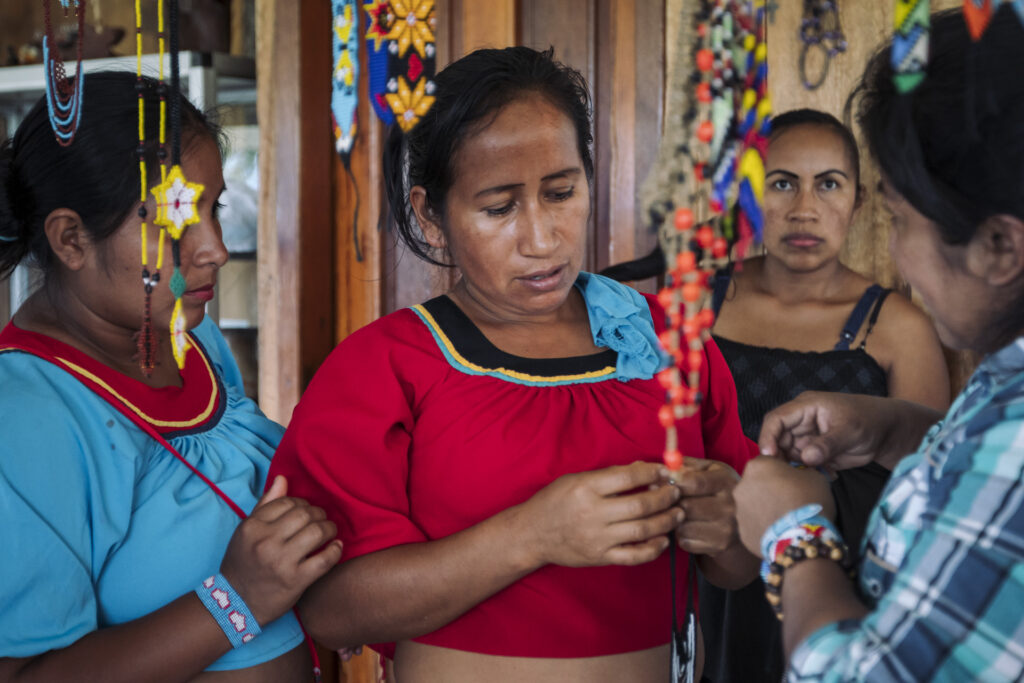By: The All Eyes on the Amazon team
It is impossible to speak of territorial defense on the Amazon, without addressing the effective exercise of human rights, such as the right to health of the peoples and nationalities that live there.
In the context of COVID-19, defending the Amazon and its living culture becomes even more challenging, since the defiance symbolized by this global pandemic is even higher in Amazonian territories, where in addition to responding to this emergency, Indigenous peoples and communities continue to face threats such as indiscriminate logging, illegal mining, oil extraction, among others, which not only increase the risk of contagion and spread of the virus; but also violate their territorial and human rights.
Until June 23, 2020, the Confederation of Indigenous Nationalities of the Ecuadorian Amazon (Confeniae) reported 649 active cases of coronavirus, 112 recovered cases, 622 suspicions, and 34 deceased, within the Kichwa, Achuar, and Shuar, Siekopai and Waorani nationalities.

The access to health services is uneven, and due to the geographical conditions of the Amazon, populations must travel for hours and long distances to access public health. This is just one of the reasons why “conventional” measures to combat COVID-19, such as social isolation and the lack of protocols adapted to indigenous contexts, result in a condition of double vulnerability.
In this context, an articulated strategy that allows access to health services with cultural and territorial relevance is essential to respond to the COVID-19 pandemic in the Amazon.
To that end, the All Eyes on the Amazon program started the construction of the Amazonian Indigenous Health Route, a coordinated response from several stakeholders to combat COVID-19 with an Amazonian indigenous cultural approach.
What is the Amazonian Indigenous Health Route?
The response to COVID-19 in the Amazon has to be strengthened. On the one hand, the high turnover of people and the difficulties in supplying essential requirements means a limitation in the response capacity to treat suspected and confirmed cases of coronavirus.
Challenges to address COVID19 in the Amazon [in Spanish]
The Amazonian Indigenous Health Route seeks to solve these problems, through a broad strategy of distributing diagnostic tests, supporting organizations, articulating actions to avoid duplication of efforts, and building – a step by step- management model, applicable in a two-dimensional way: from the health system and from the cultural realities of indigenous communities.
On the other hand, epidemiological surveillance – to identify and isolate suspected cases – as well as the promotion of prevention and assistance measures, need to be culturally adapted, democratizing the response to the virus, through participatory construction processes that guarantee the appropriation of these measures, thus reducing the risk of contagion and spread.

For its development, Hivos formed a technical team of professionals in the areas of medicine, anthropology, geography and communication, who are leading the dialogue with representatives of the local peoples of the indigenous territories where the All Eyes on the Amazon program works; in coordination with the Ministry of Public Health, CONFENIAE, Alianza Ceibo, PSHA, COICA, FENASH-P, NAE, USFQ, technical advice of the Pan American Health Organization in Ecuador and exchanges with civil society organizations working in the Ecuadorian Amazon. Thus, we hope to generate applicable, timely and relevant response protocols to the specific health needs of the Amazon region.
For these response protocols, it is essential to understand how the Indigenous peoples and nationalities of the Amazon perceive COVID-19; thus, a first phase of the route (in which it is currently in) consists on identifying the various narratives each community has to understand the pandemic, which allows to generate response models closer to their reality.
Through these identification of narration, we recognize points of encounter with the health system, identifying the technical needs to accelerate the response capacity of suspected and confirmed cases of coronavirus in the Amazon. Thus, in addition to strengthening the application of diagnostic tests by PCR and rapid tests, protocols of immediate response are generated through epidemiological surveillance – without detriment to a confirmatory laboratory test -, for a corresponding response in terms of isolation, identification of epidemiological areas and application of treatments such as oxygen therapy.

Next steps:
The participatory construction of this model will result in a risk map, which will graphically represent a step-by-step access to health services, with a cultural focus, in response to combating the COVID-19 pandemic.
Furthermore, this model will be accompanied by communication materials adapted to the realities of each community, with cultural and linguistic relevance, so that community health promoters disseminate prevention and care mechanisms; a fundamental tool to stop the spread of COVID-19.
We hope that this exercise will become an unique model of collaborative work between academia, civil society, and the public sector to promote the effective exercise of the right to health of Indigenous peoples and nationalities of Ecuador, applicable to other transmitted diseases and illnesses, contributing to the construction of an inclusive health system, focused on Amazonian individuals and communities.

